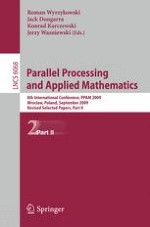2010 | Buch
Parallel Processing and Applied Mathematics
8th International Conference, PPAM 2009, Wroclaw, Poland, September 13-16, 2009, Revised Selected Papers, Part II
herausgegeben von: Roman Wyrzykowski, Jack Dongarra, Konrad Karczewski, Jerzy Wasniewski
Verlag: Springer Berlin Heidelberg
Buchreihe : Lecture Notes in Computer Science
